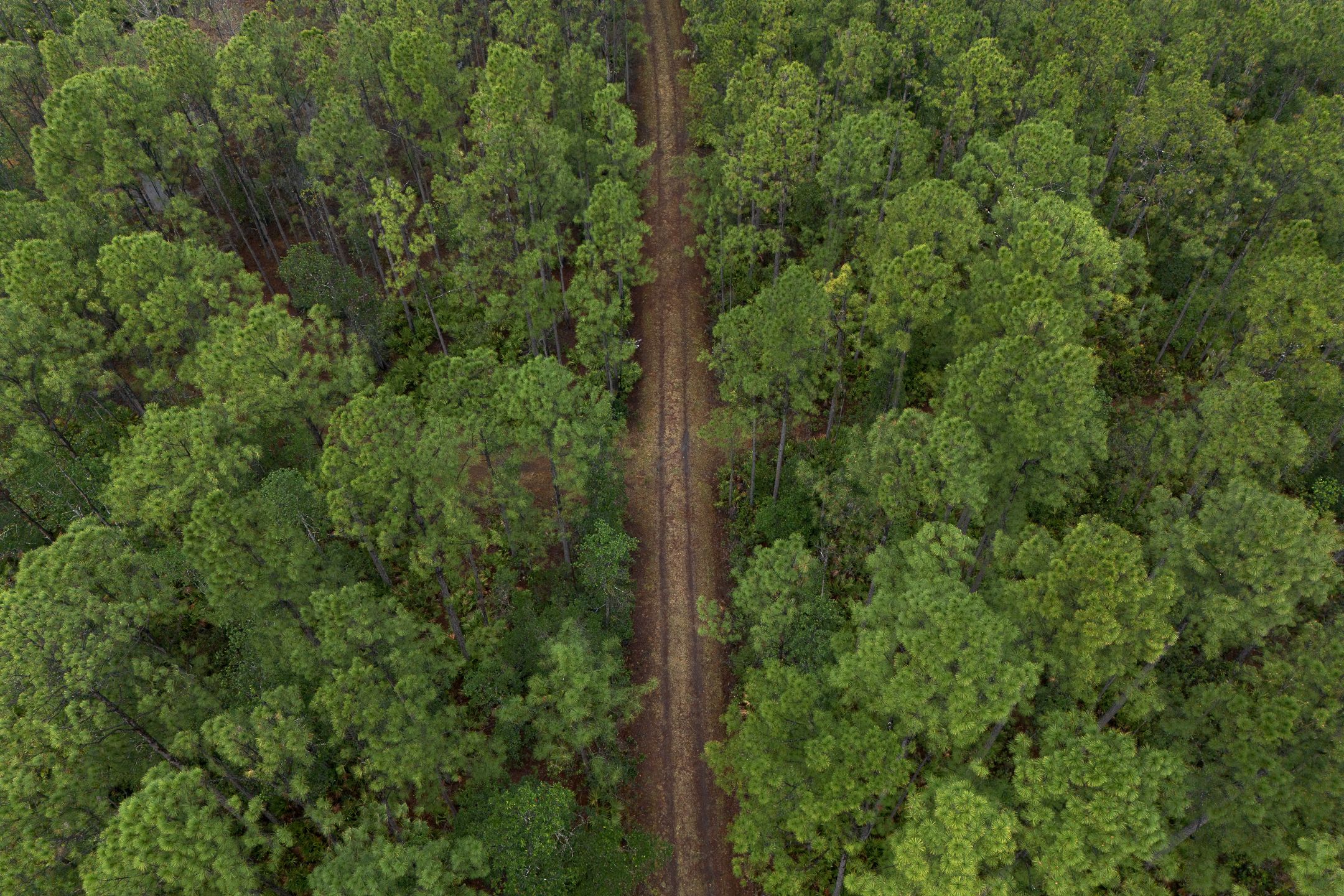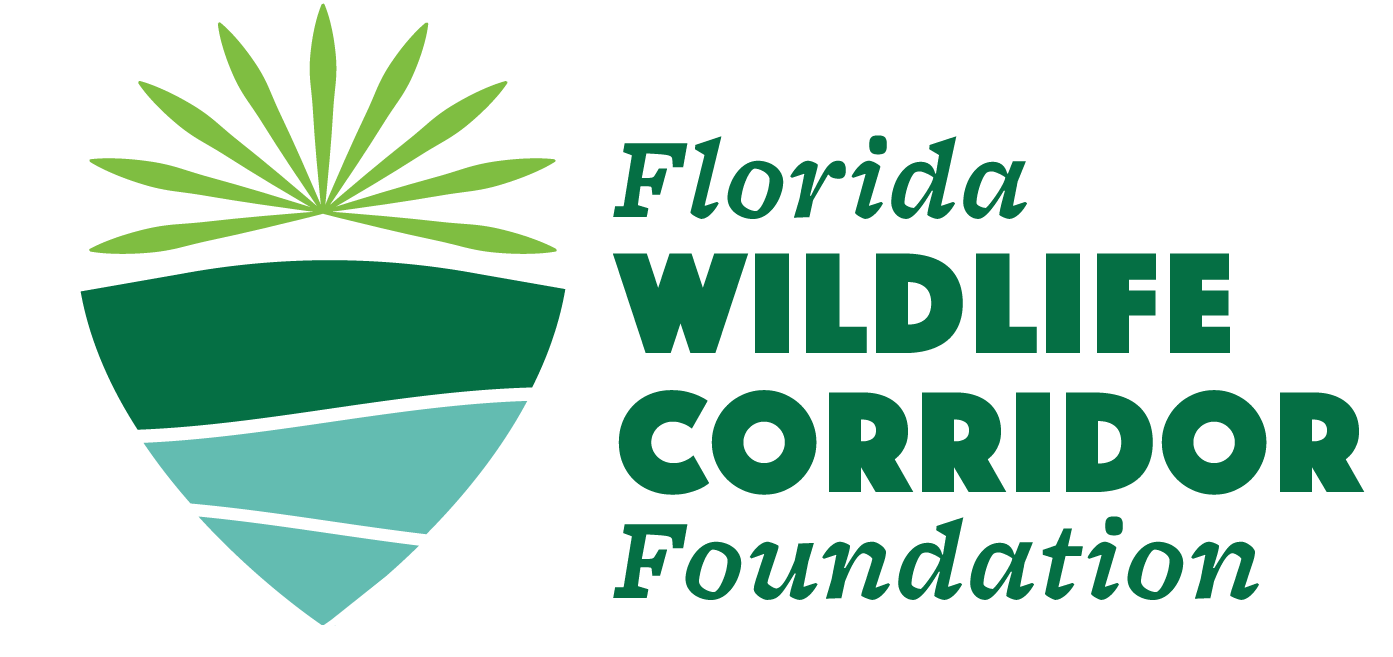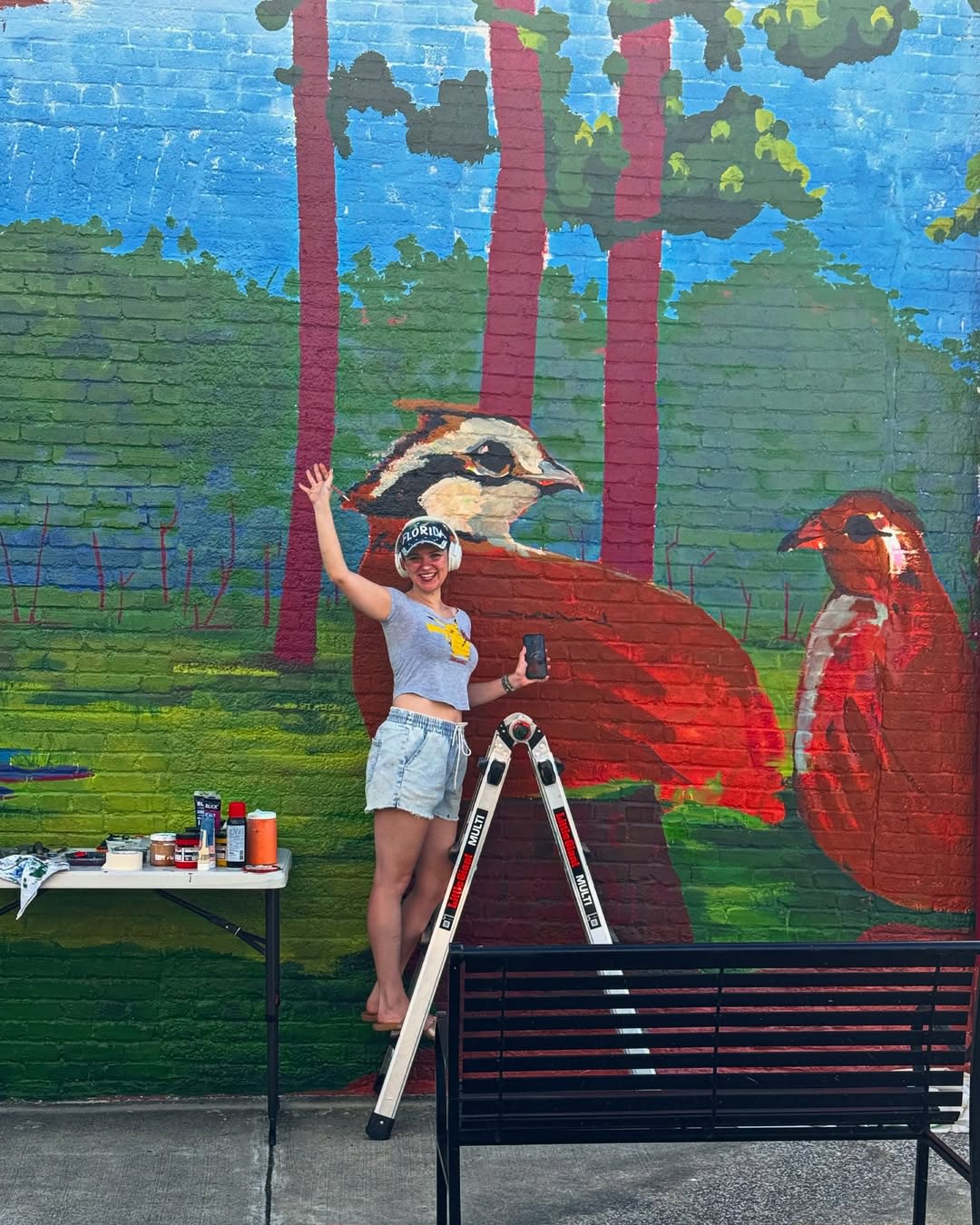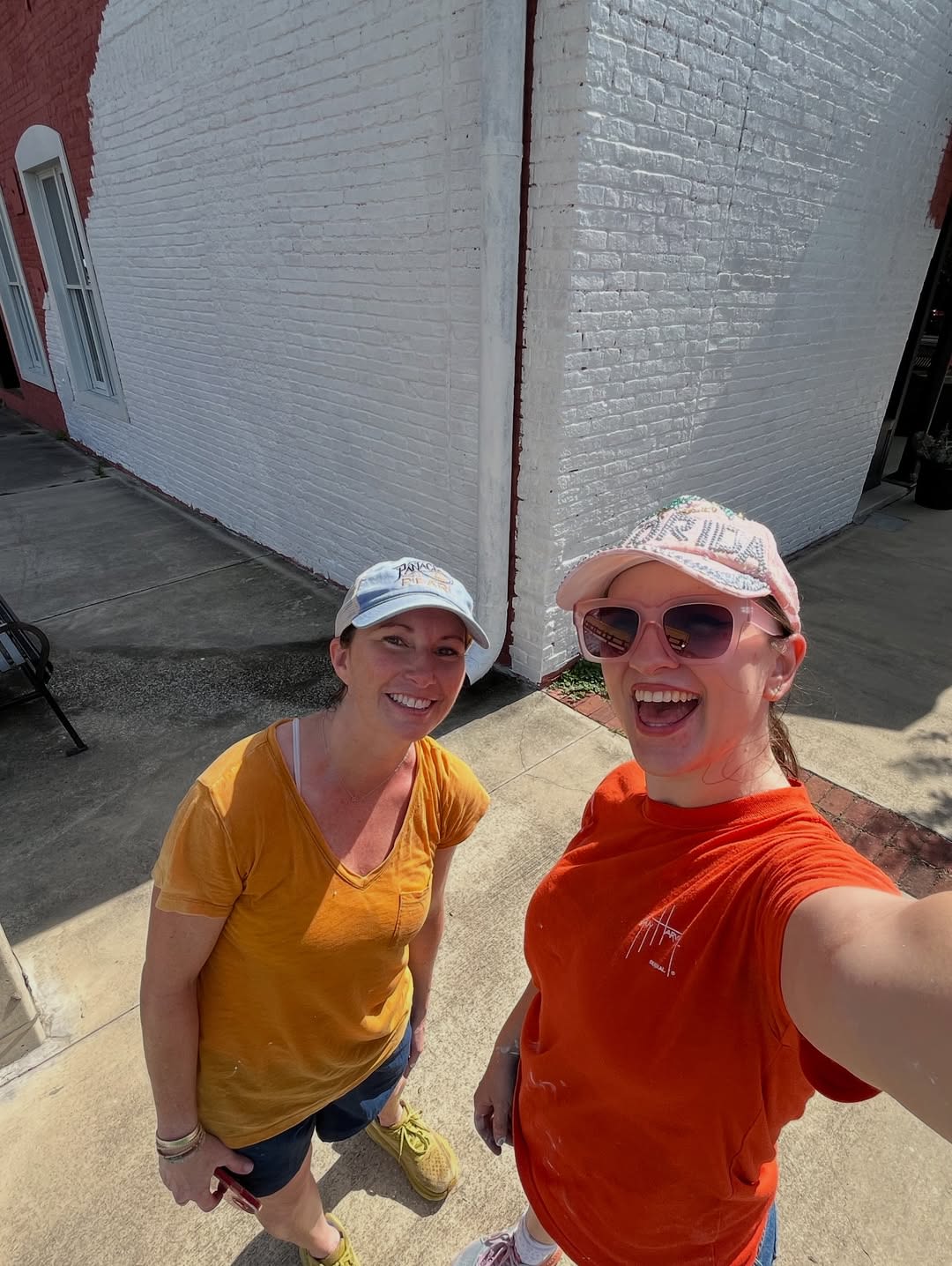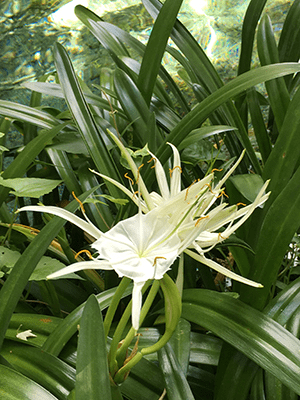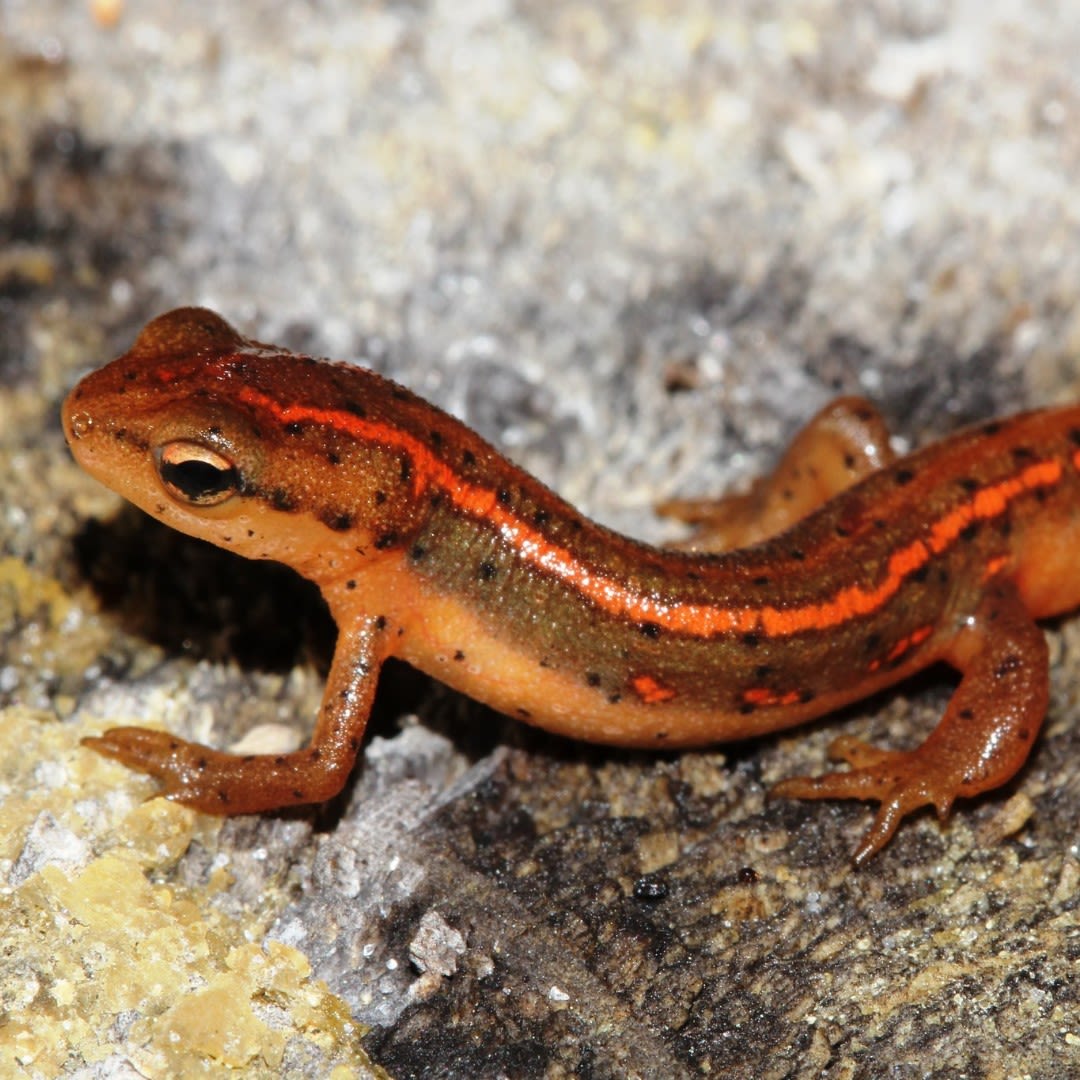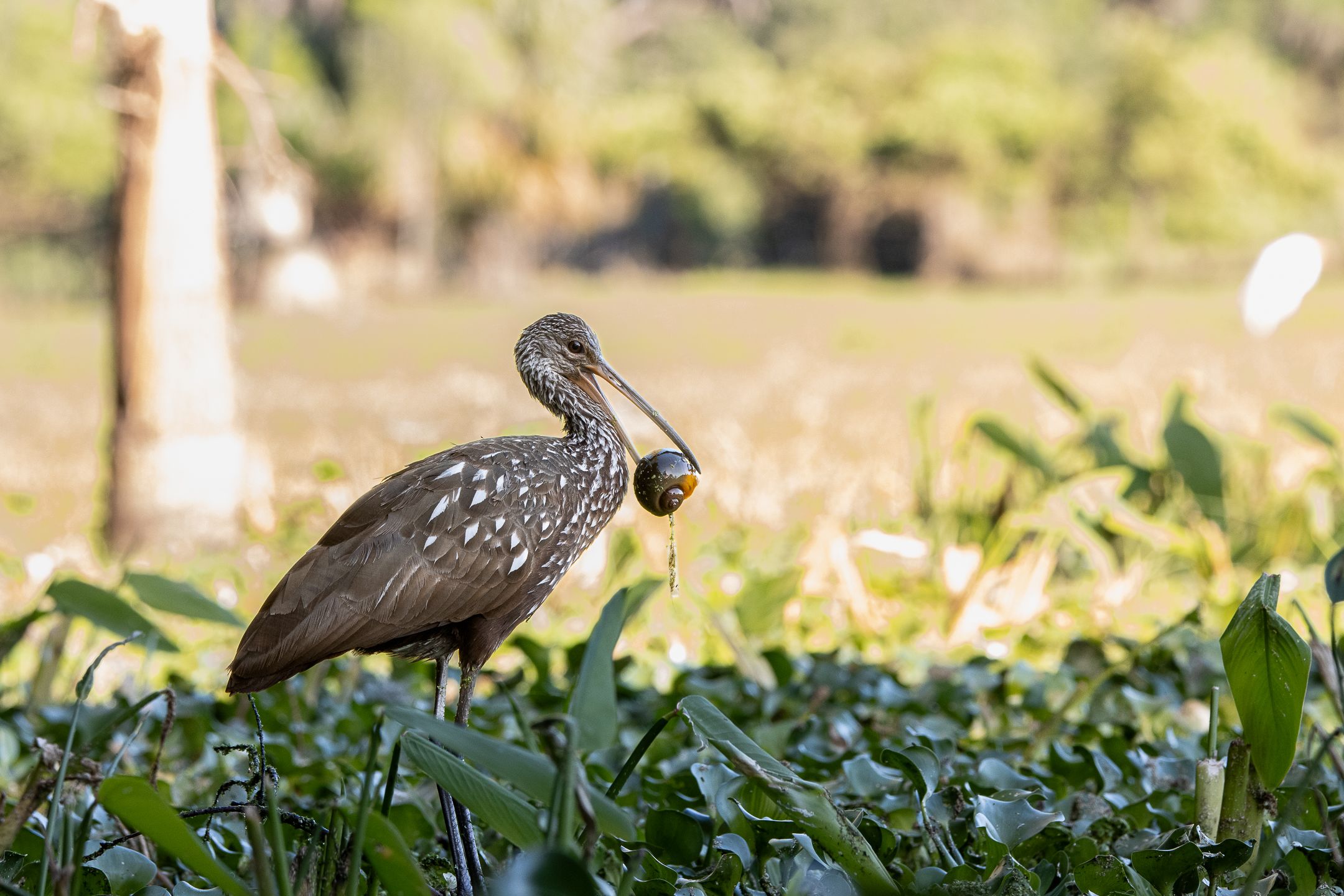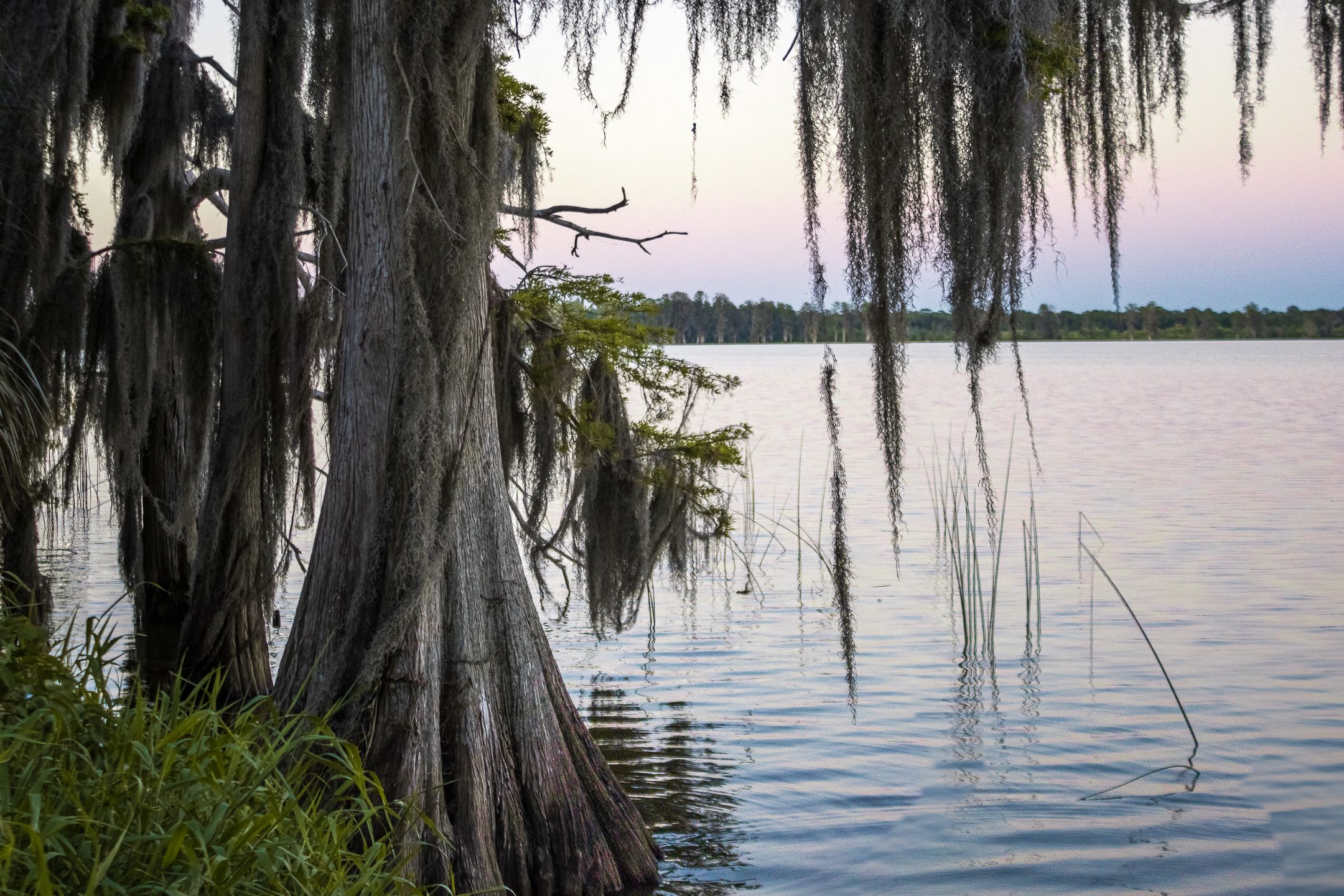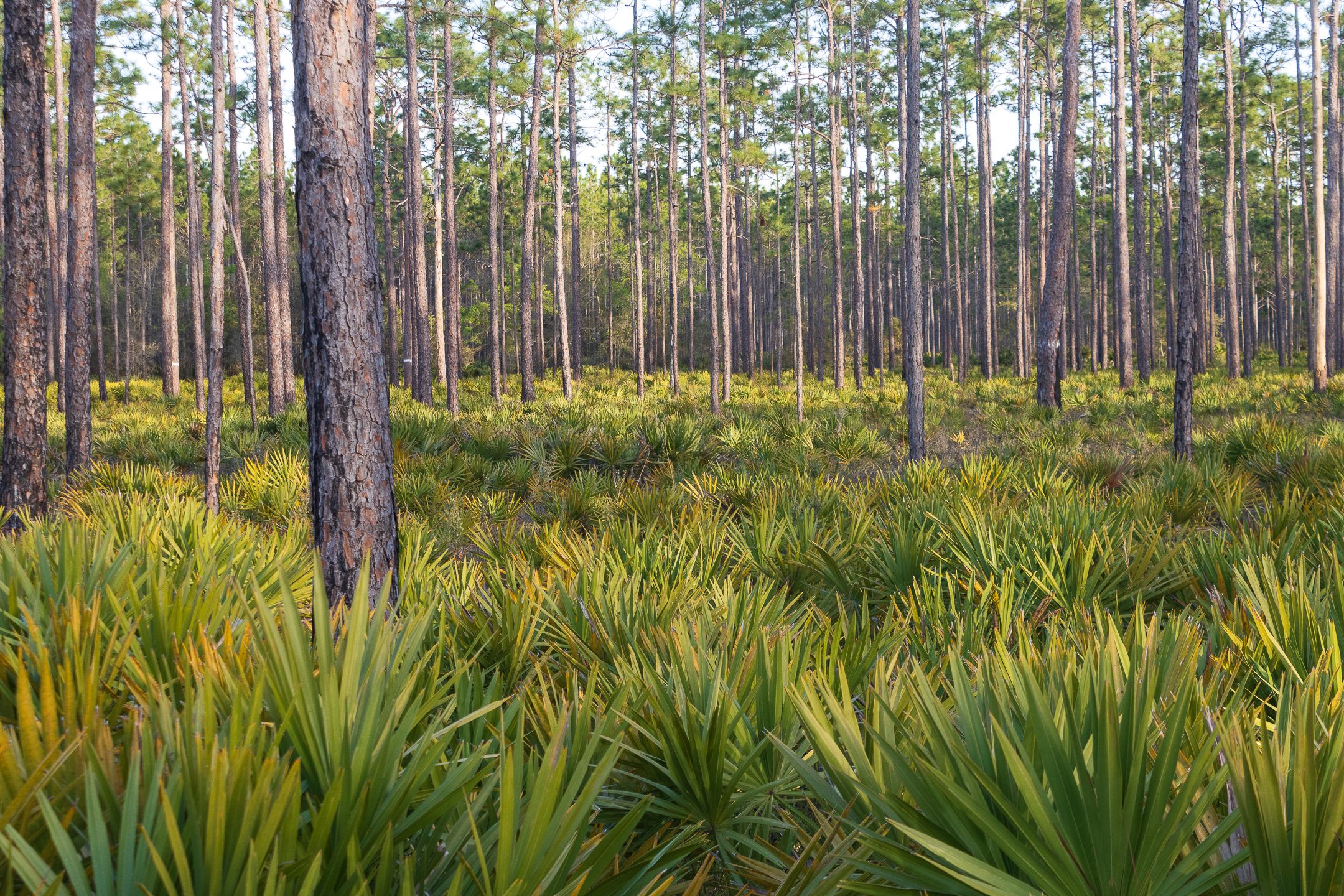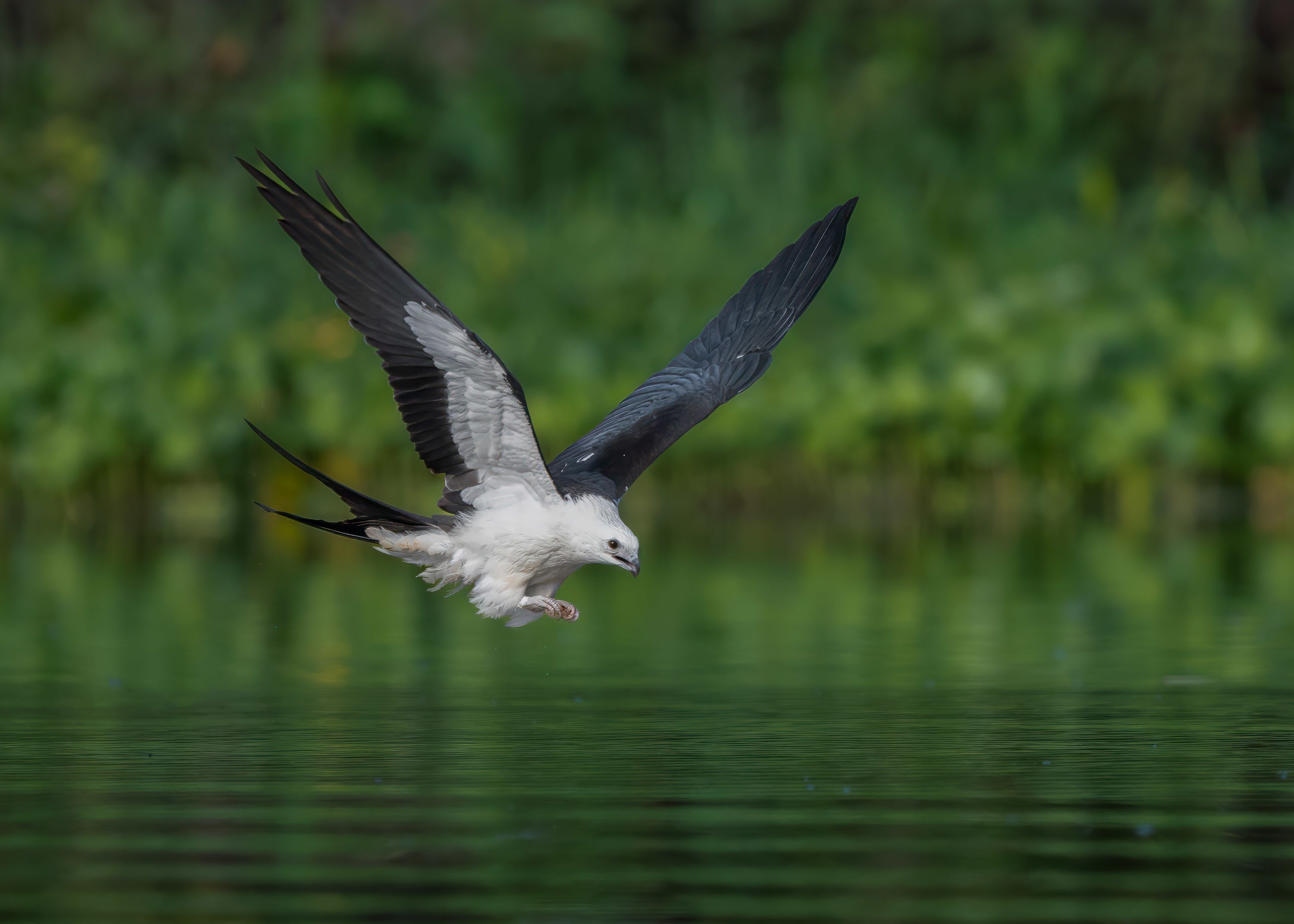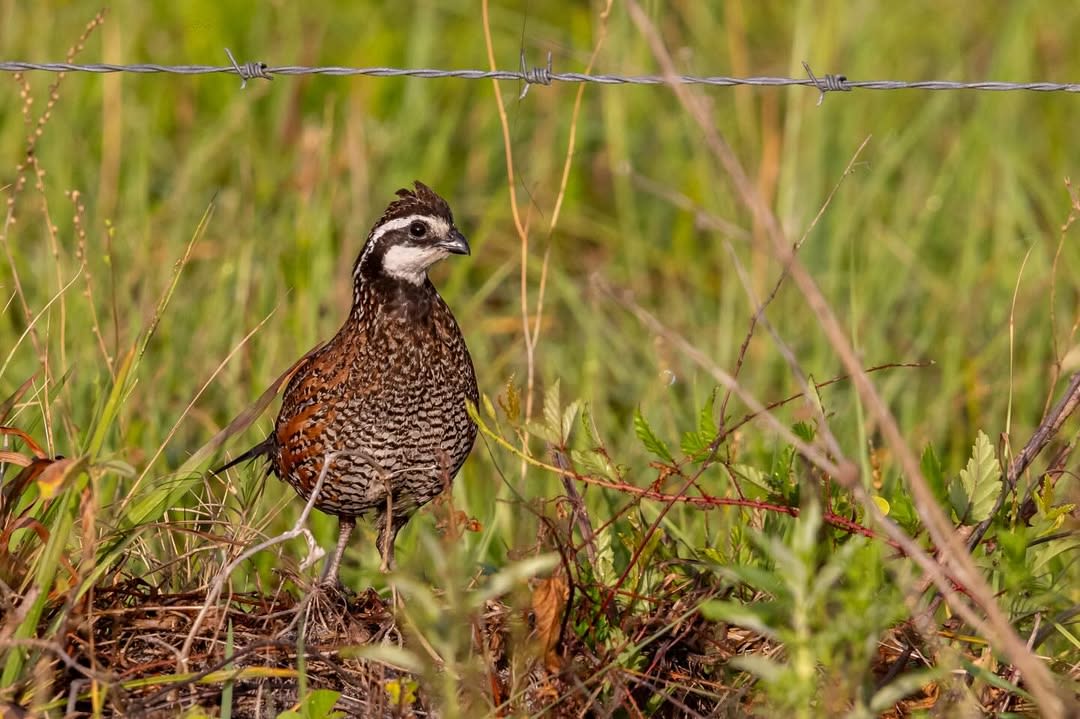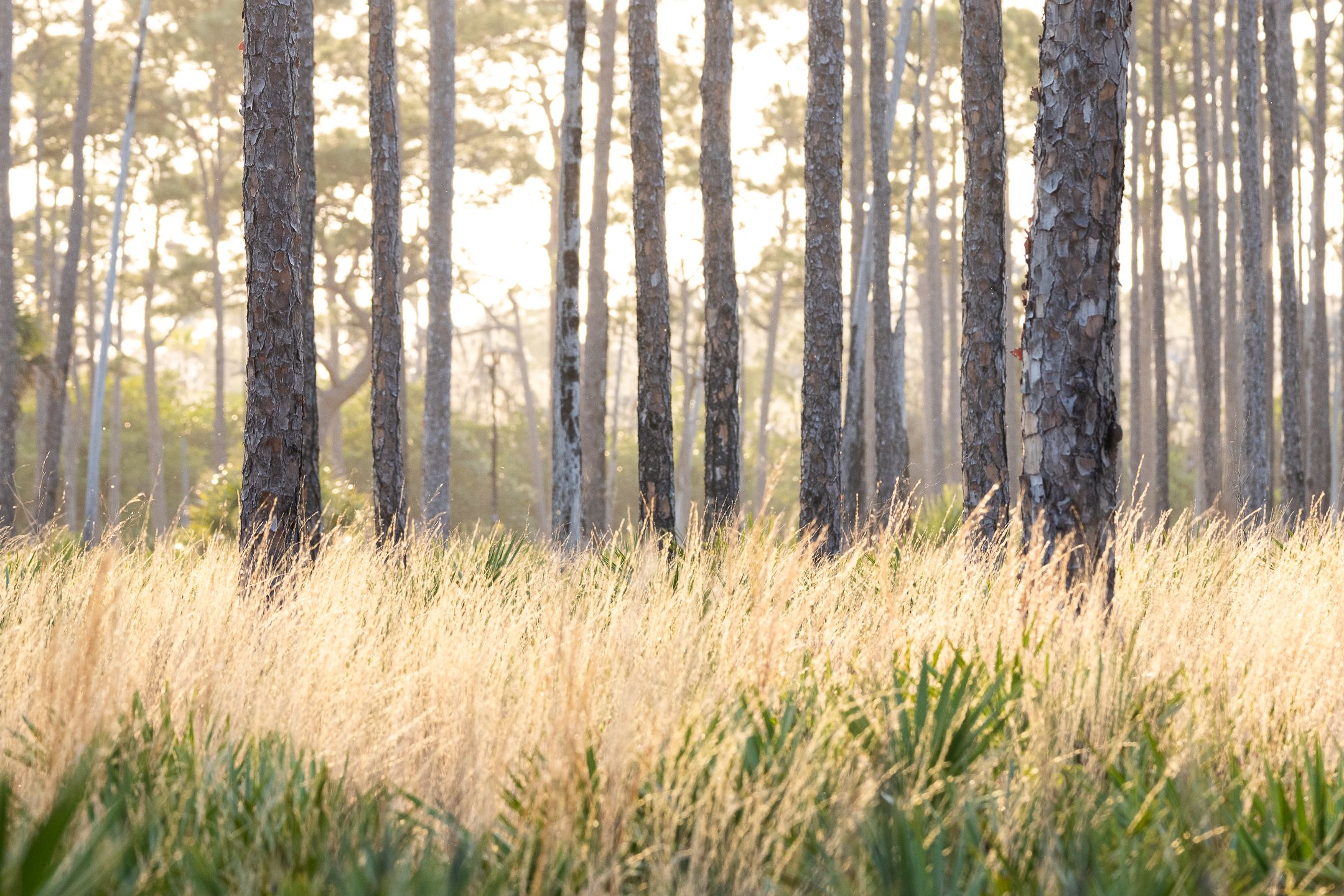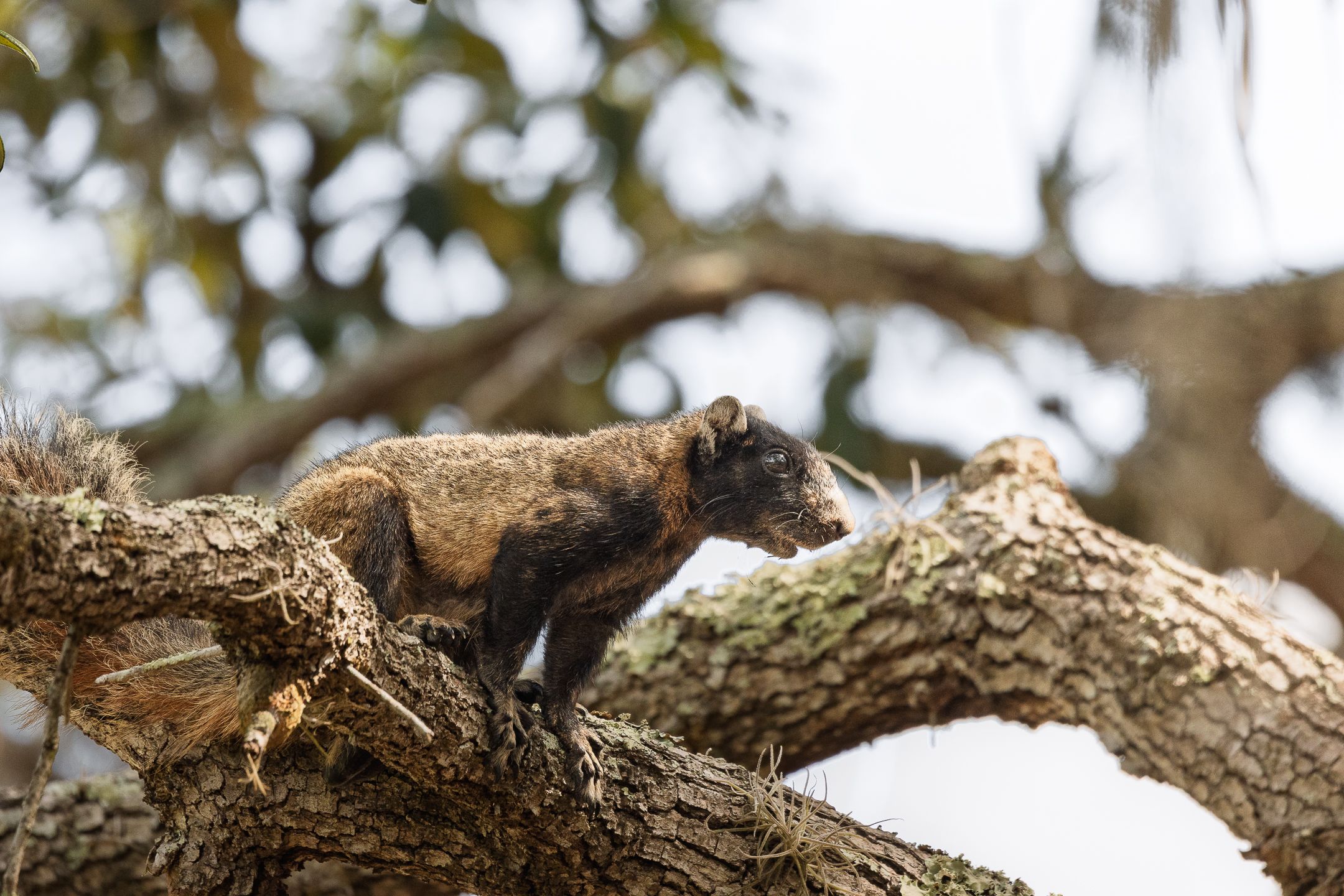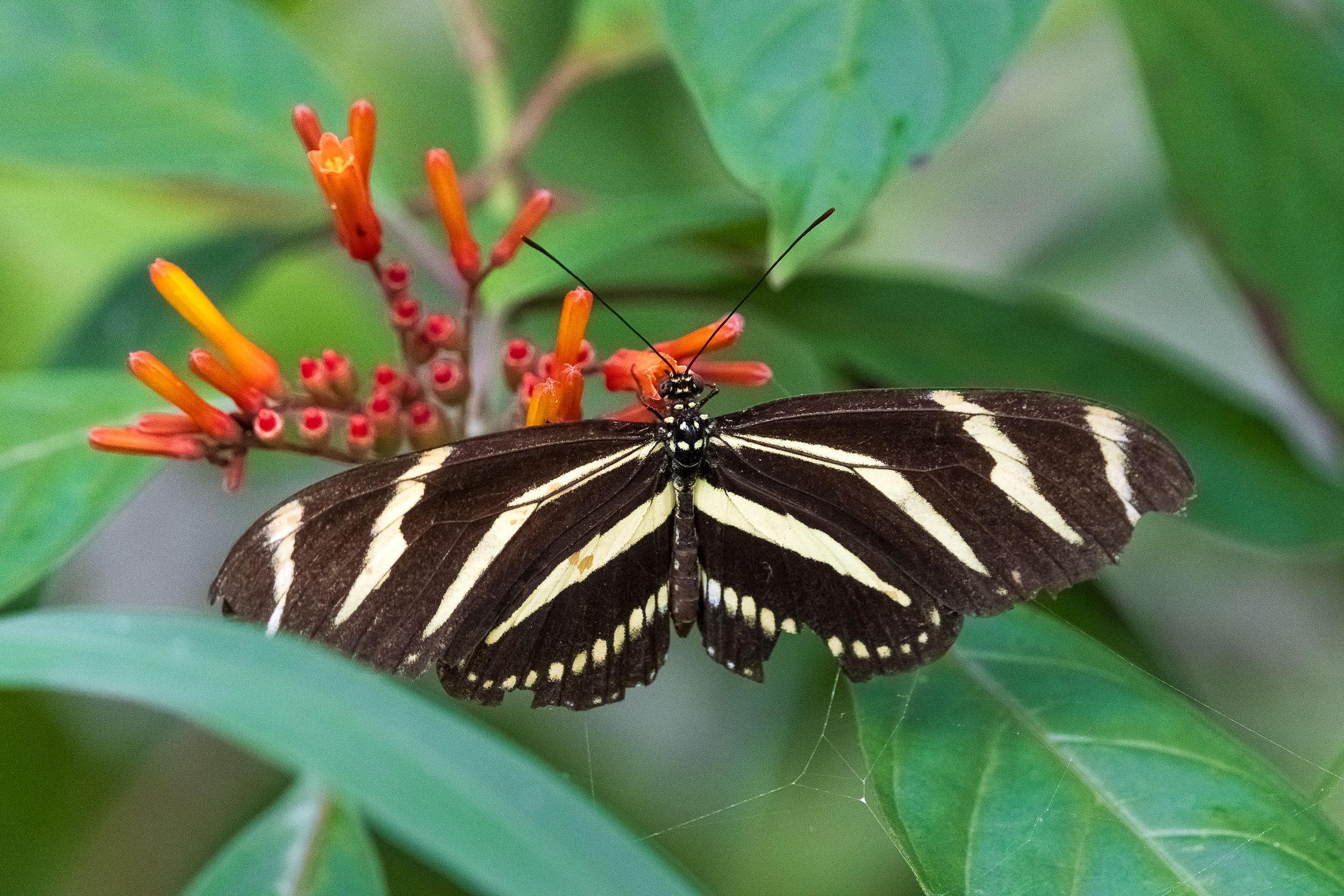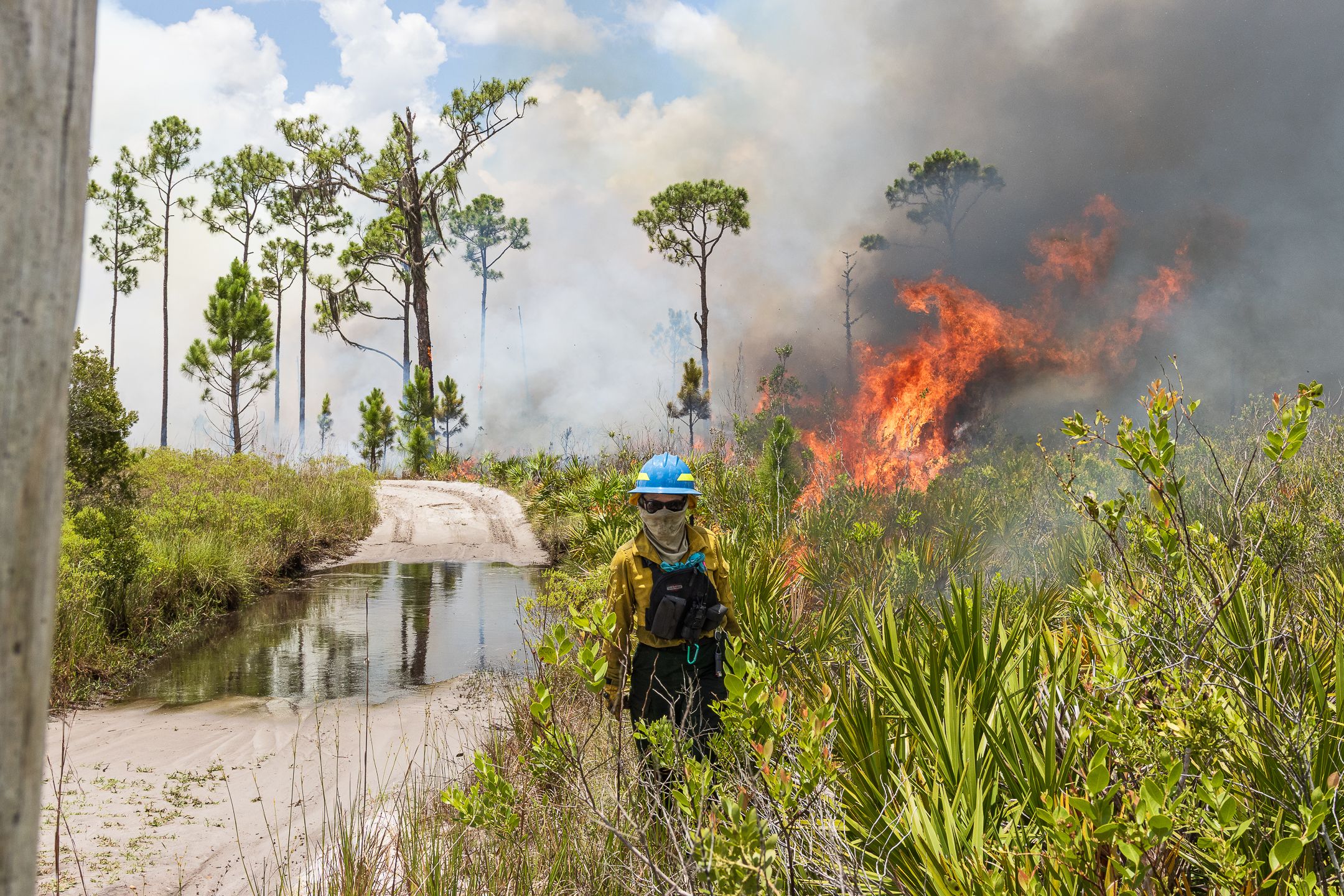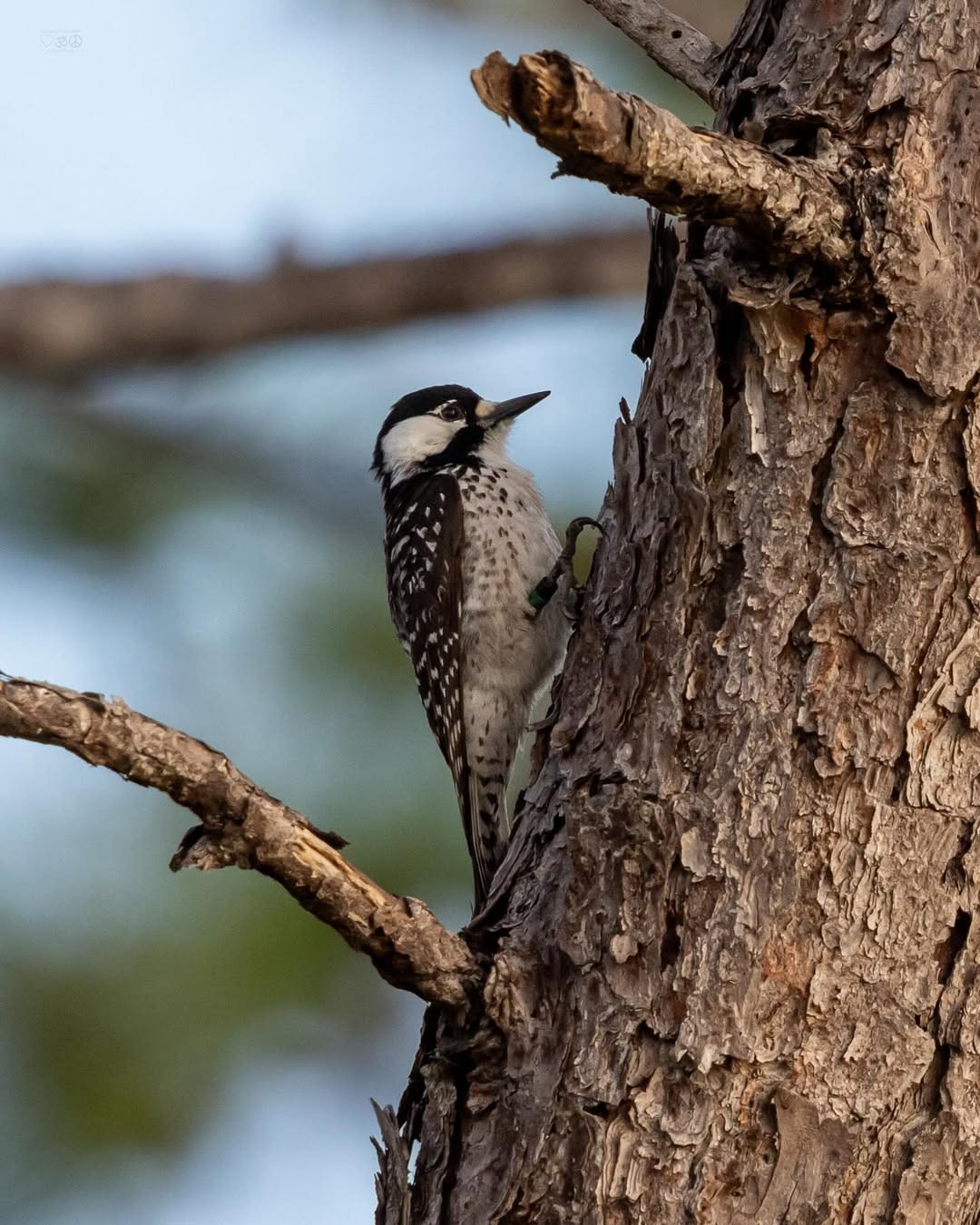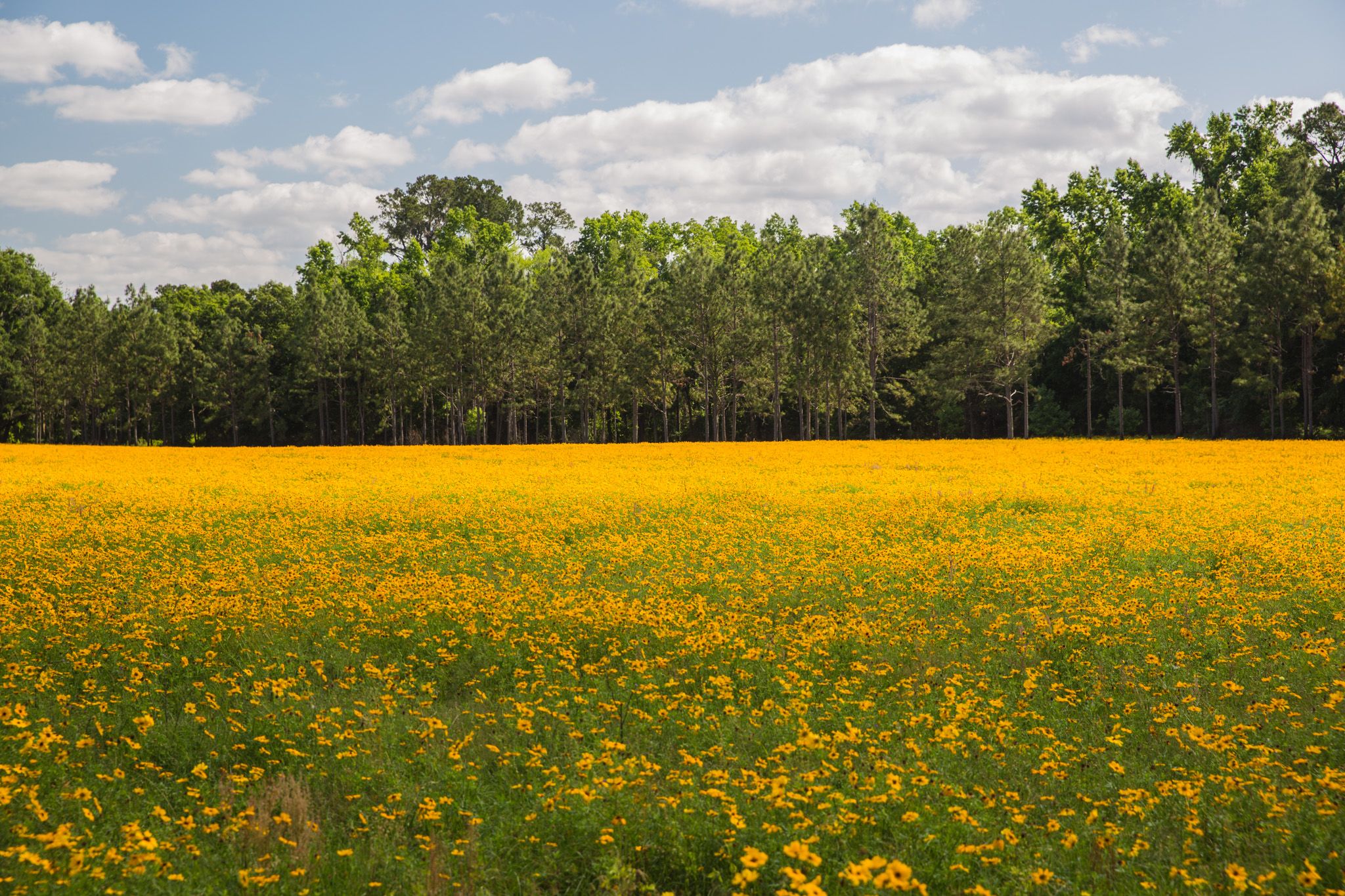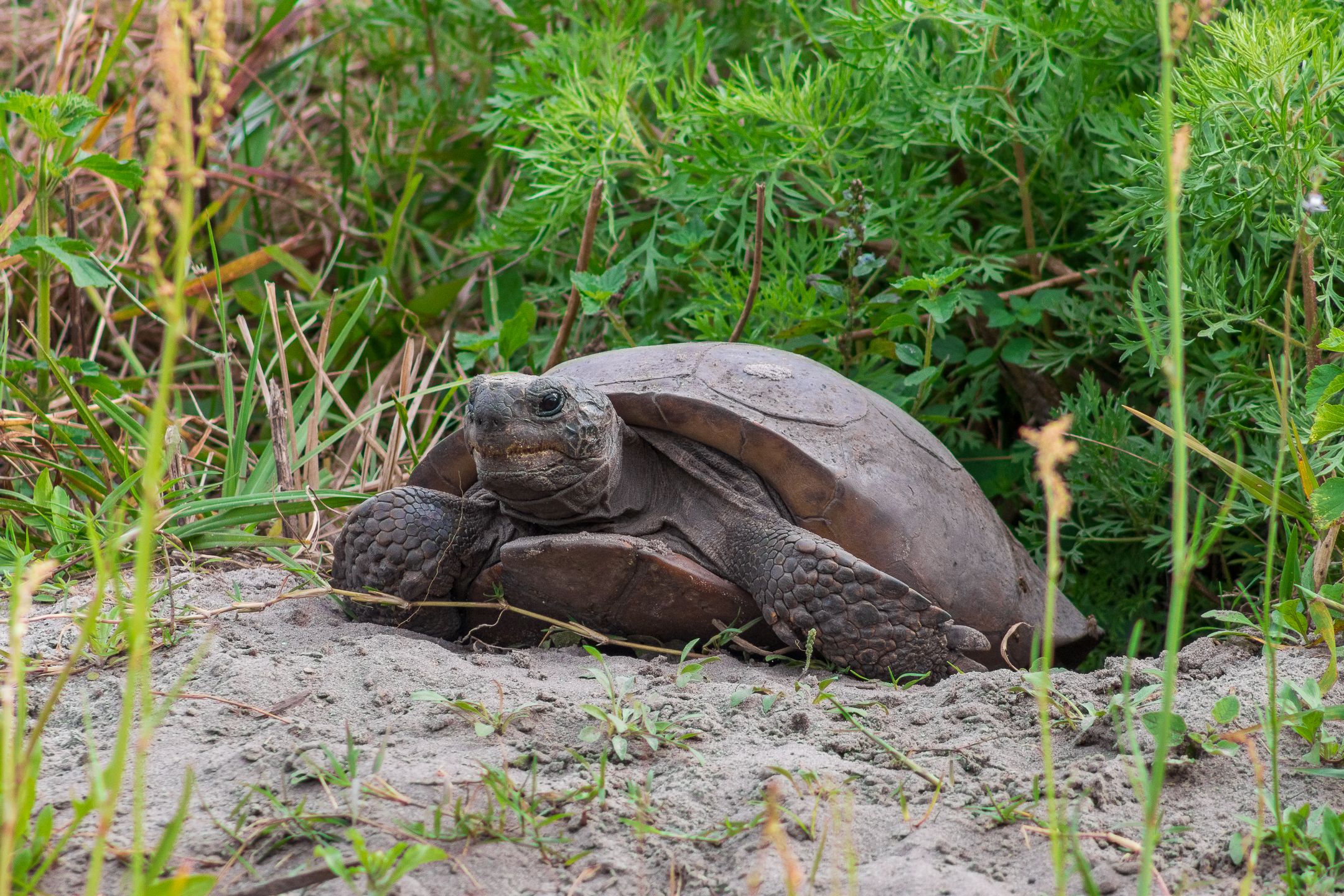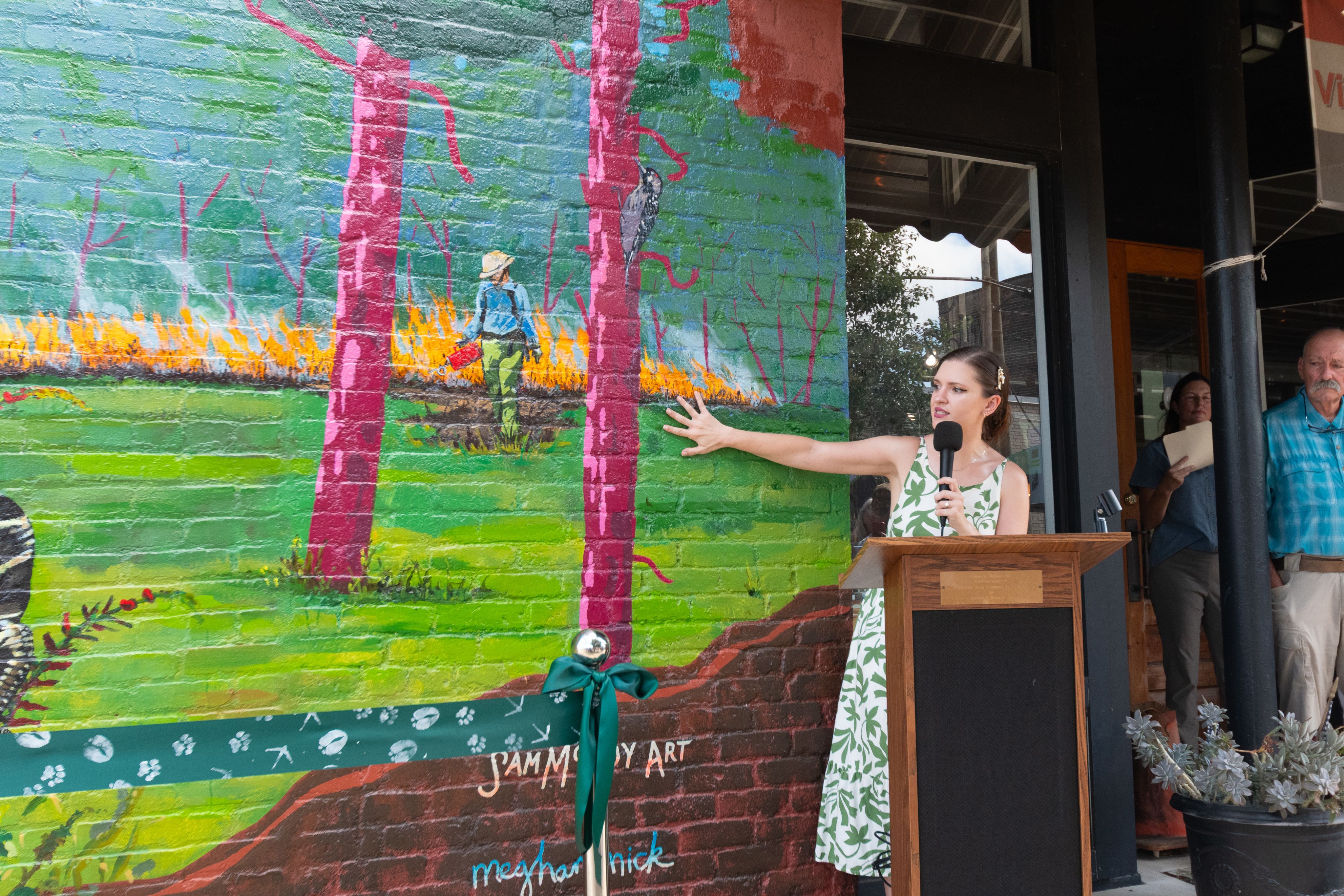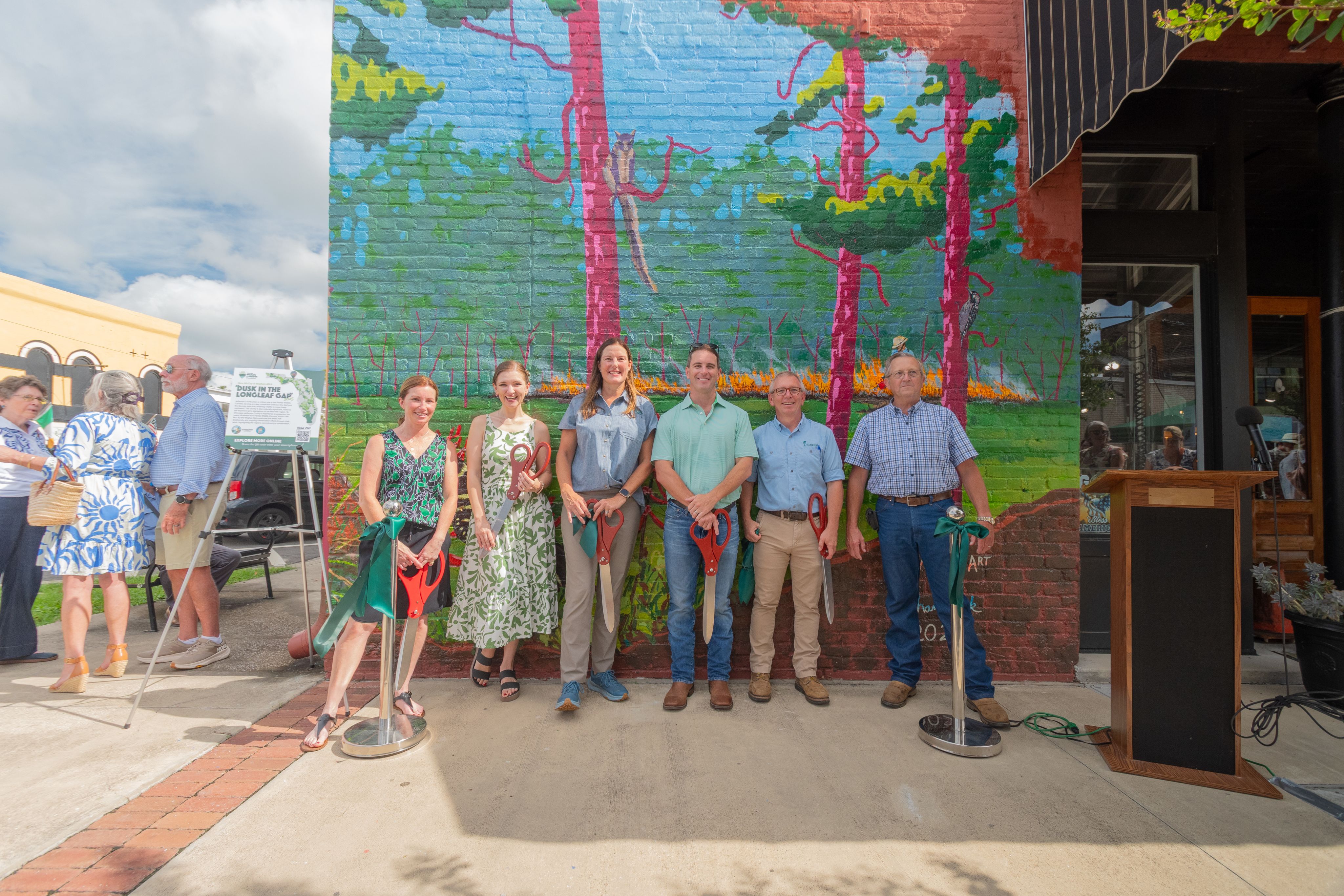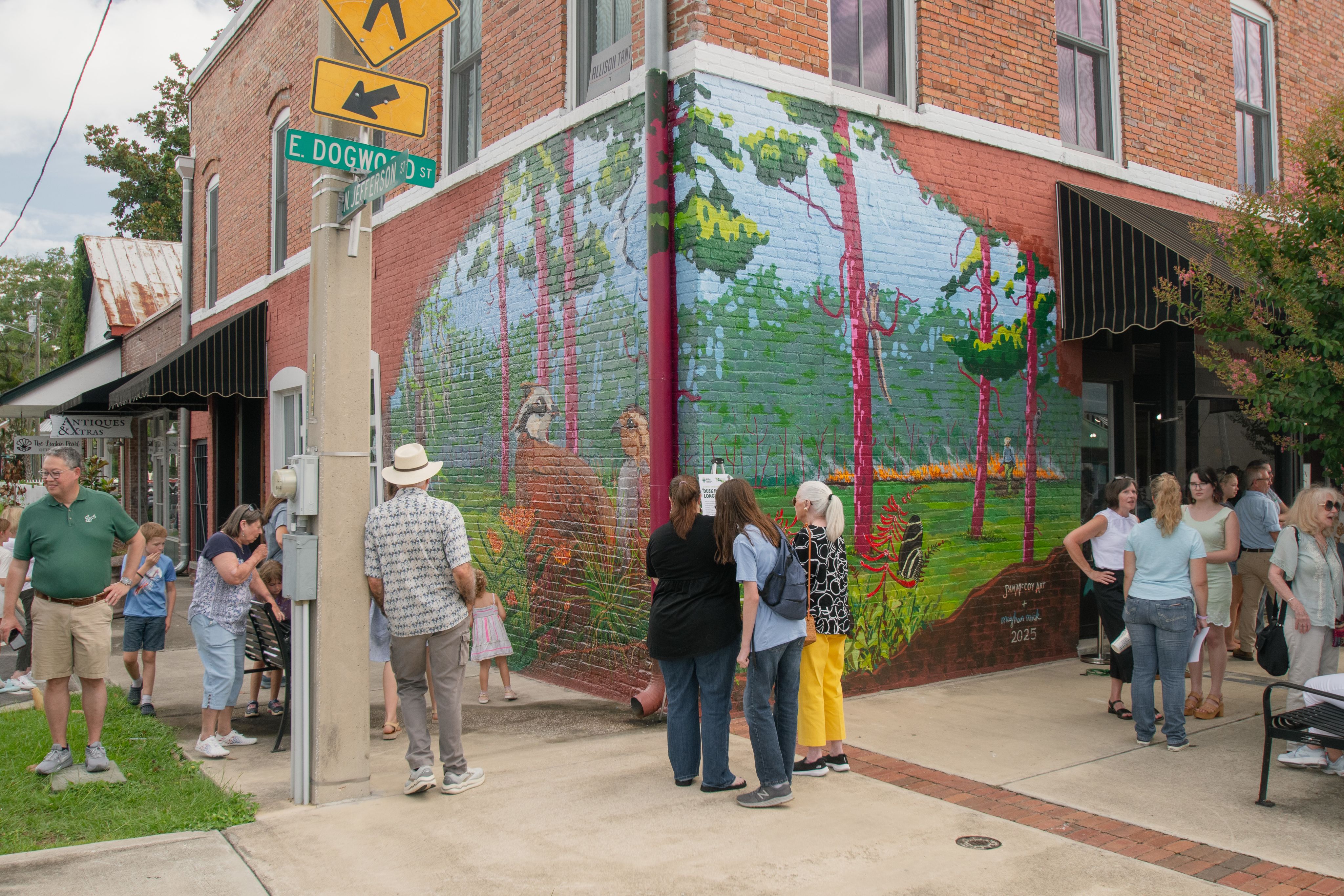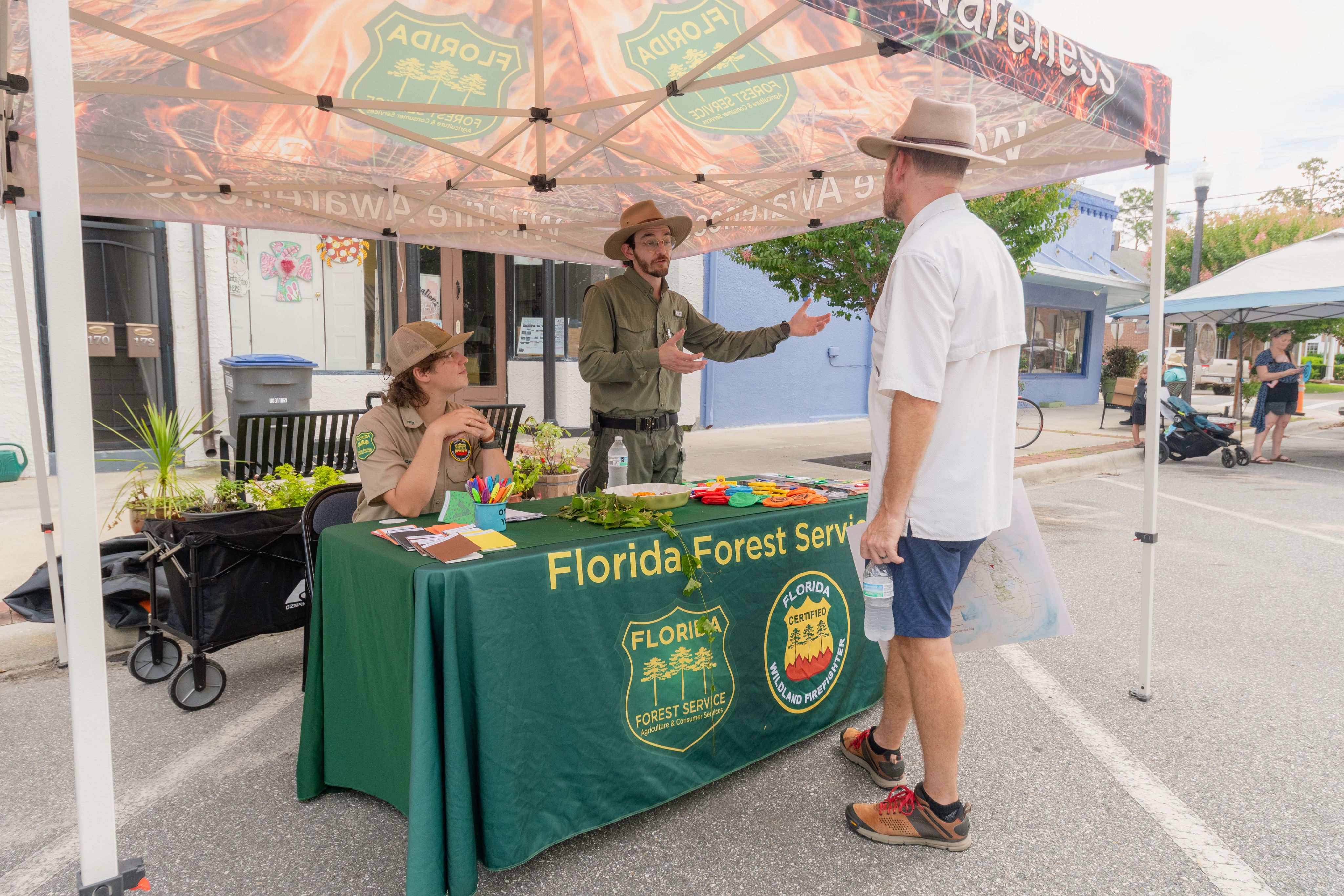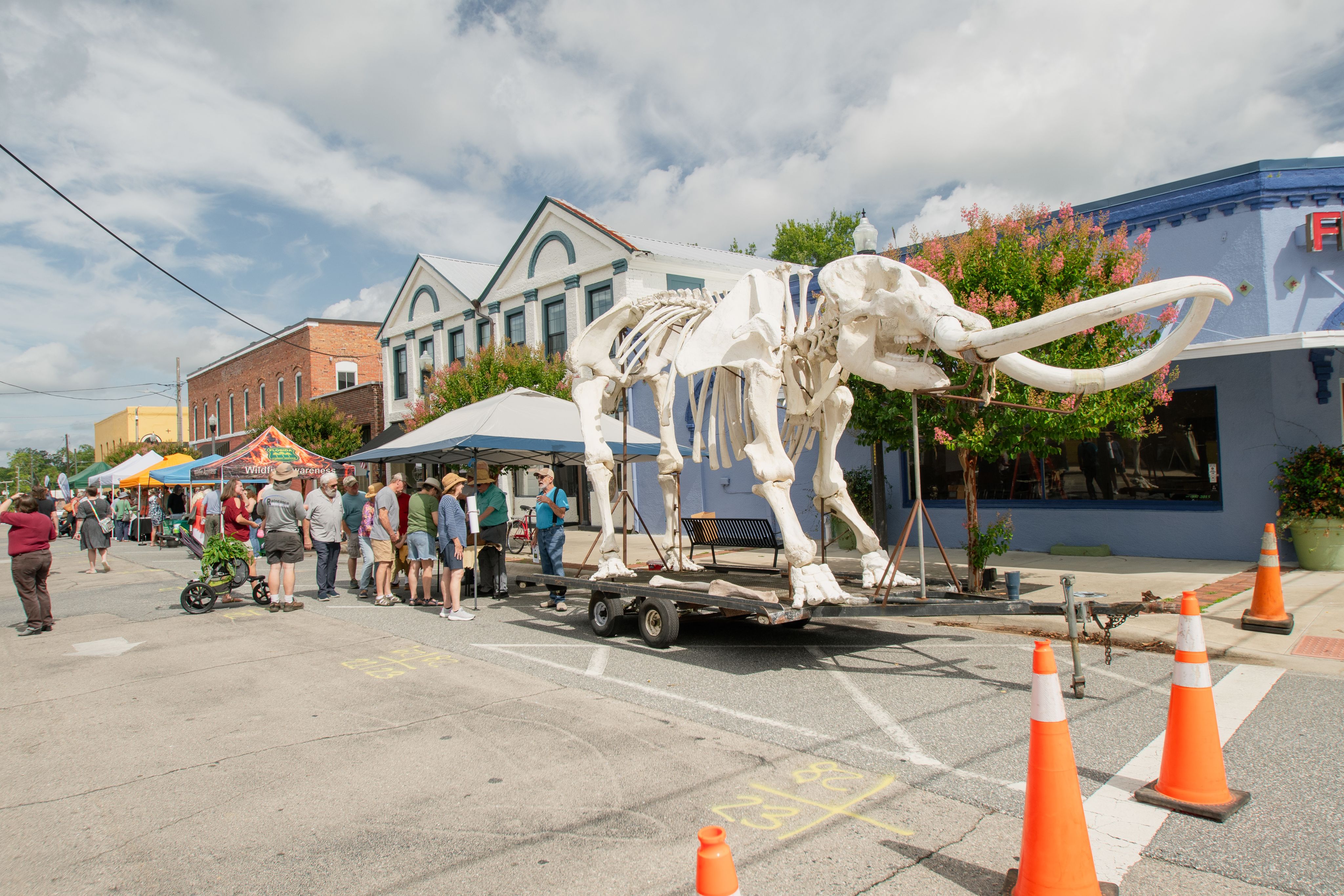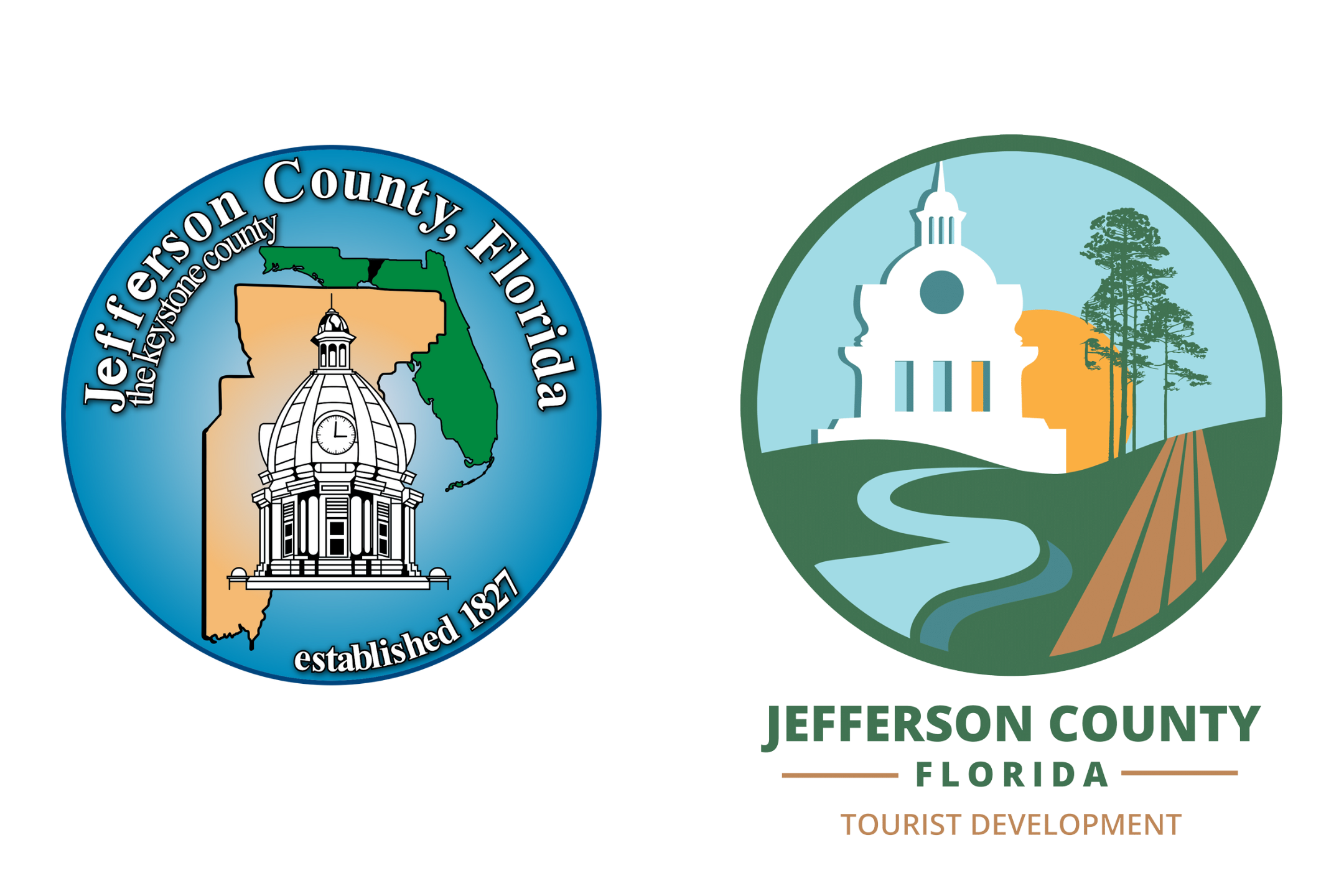Dusk In The Longleaf Gap
By Artists Sam McCoy & Meghan Mick
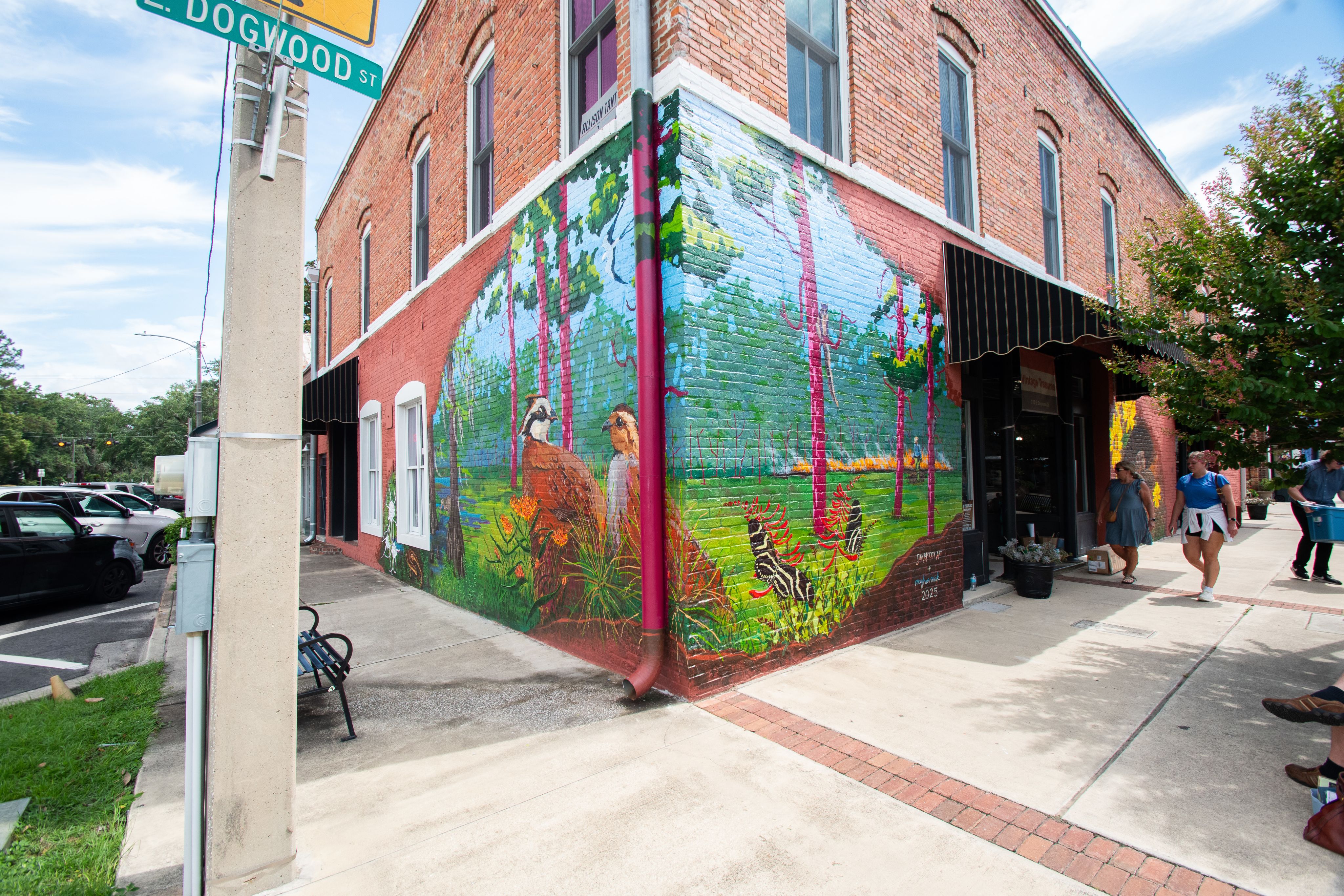
The Florida Wildlife Corridor is an 18-million-acre statewide network of connected lands and waters that supports wildlife and people.
Seen in dark green, 10 million acres are protected as federal lands, state parks and forests, county lands, water management district lands, or private lands under conservation easements.
The remaining 8 million unprotected acres in light green are opportunity areas for conservation and are mostly comprised of agricultural working lands, such as cattle ranches and timber land. Not only do these valuable spaces provide food and fiber for Florida and our nation, but they also provide interconnected landscapes that keep Florida’s wild spaces connected.
Our Mural Campaign is aimed at raising awareness of the importance of the Florida Wildlife Corridor in areas with the greatest ecological significance that have the highest risk of development by 2030.
The geography of Jefferson County serves as a vital connection point in the Corridor, allowing wildlife to move from North Florida to the Panhandle and into Georgia, Alabama, and beyond. On the north side of the county you have the Red Hills Region, in the south along the coast is St. Marks National Wildlife Refuge, and to the east is the Aucilla River.
Jefferson County is home to important fauna like the Florida Black Bear, Northern Bobwhite Quail, Gopher Tortoise, and Southern Fox Squirrel. Protecting wild spaces in Jefferson County not only gives these species room to roam, but allows locals and visitors alike to enjoy an abundance of outdoor recreational activities such as hiking, biking, kayaking, camping, hunting, and fishing.
Without thoughtful conservation and planning the connected landscape will be lost, resulting in diminished wildlife populations, degraded water quality and negative impacts on the outdoor recreation and ecotourism important to the local economy.
Meet The Artists
Samantha (Sam) McCoy is a Tallahassee-based artist known for her contemporary landscape paintings. With over a decade of professional experience, she describes herself as a hyper-local artist, drawing inspiration from Florida’s diverse ecology and layered history of tourism.
Meghan Mick is a landscape architect and artist, also based in Tallahassee. A native of the area, her work focuses on connecting people to place — whether through immersive design or visual storytelling.
Sam and Meghan have been co-teaching Graphics in Florida State University’s Department of Interior Architecture and Design for the past few years. Their shared passion for native landscapes and wildlife sparked this creative collaboration.
Click here to learn more from Sam’s website and Meghan’s website.
"Dusk In The Longleaf Gap" by Sam McCoy & Meghan Mick showcases the iconic flora and fauna found in and around Monticello and Jefferson County.
The Florida Fish and Wildlife Conservation Commission (FWC) manages fish and wildlife resources for their long-term well-being and the benefit of people. Thanks to their contributions, you can learn more about the species in this mural. Scroll to learn about each of the species featured.
Photo by UF IFAS
Photo by UF IFAS
Spider Lily
(Hymenocallis)
The spider lily is a Florida native with attractive foliage and fragrant white blooms. Florida is a diversity hotspot for the spider lily and is home to 13 of the 16 species native to the United States with seven of them only found in Florida.
This clumping perennial has long, dark green leaves that grow directly from an underground bulb and reach a height of two to three feet. In summer and fall, the spider lily produces many gorgeous white flowers that are fragrant, long-lasting, and delicate.
Photo by Florida Fish & Wildlife Conservation Commission (FWC) Staff
Photo by Florida Fish & Wildlife Conservation Commission (FWC) Staff
Striped Newt
(Notophthalmus perstriatus)
Striped newts are found in southern Georgia and northern Florida with populations occurring in the Panhandle and Peninsula, separated by the Aucilla River lowlands. Terrestrial adults use dry upland habitats, most frequently sandhill but can also inhabit scrub, scrubby flatwoods, and mesic flatwoods that surround breeding ponds during the non-breeding season. The use of prescribed fire is important to manage this habitat because striped newts rarely use unburned habitats that are encroached by hardwoods.
The striped newt is protected as a state-Threatened species under Florida’s Endangered and Threatened Species Rule and is included in Florida’s Imperiled Species Management Plan.
Photo by Ethan Coyle
Photo by Ethan Coyle
Limpkin
(Aramus guarauna)
The limpkin is a long-legged species of waterbird that has dark brown feathers with streaks of white on the head and neck and absent on the rest of the body. The key physical feature of the limpkin is their down-curved bill, which is used to feed on their primary prey, apple snails.
Limpkins feed primarily on apple snails, but they will also eat insects, worms, and mussels. Limpkins will walk in shallow waters searching for apple snails and utilize their down-curved bills to get the snail out of its shell.
The limpkin inhabits shallows along rivers, streams, lakes, and in marshes, swamps and sloughs in Florida. Limpkins are fairly widespread in peninsular Florida, but rarer in the Panhandle and Keys. In the U.S., the Limpkin is found only in Florida and southern Georgia.
Photo by Ethan Coyle
Photo by Ethan Coyle
Bald Cypress
(Taxodium distichum)
Bald Cypress trees tend to grow in forested wetlands, along streams and rivers, in spring runs and ponds, and in places with still or slow-moving water. Bald Cypresses are the most flood-tolerant of all Florida's trees, which is why they dominate swamps that have long flood periods. Bald Cypress swamps are home to many species, with large mammals and birds especially take advantage of the plant density and hollow trees of the swamps.
They are known for their pneumatophores (knees) which function to transport air to drowned roots underground and their buttressed (flared) trunks which both work together to keep the tree stable in its wet environment. Bald Cypress trees can grow up to 150 feet and reach six feet in diameter and have flat leaves that grow on both sides of the branchlets.
Photo by Ethan Coyle
Photo by Ethan Coyle
Longleaf Pine
(Pinus palustris)
Longleaf pine is an evergreen conifer that gets its name for having the longest leaves of the eastern pine species. The historic range of the longleaf pine once extended from southeastern Virginia to Florida, and west through Louisiana to east Texas. Now just 5 to 6% of the historic ecosystem remains.
Longleaf pine is unique in being both a pioneer species (the first to colonize a disturbed area) and a key member of the climax community (the final, stable ecosystem). In the wild, longleaf pine forests develop a stable grassland ecosystem, home to a rich variety of plants and animals. Fire is an important part of both the ecosystem and the pine population’s health. Regular burns remove competing vegetation and expose the bare soil needed for seeds to germinate.
Photo by Alexander Wallace
Photo by Alexander Wallace
Swallow-tailed Kite
(Elanoides forficatus)
The sight of a swallow-tailed kite is unforgettable: a black-and-white bird of prey with a deeply forked tail soaring through the summer sky.
After spending the fall and winter in South America, kites arrive in Florida in early March to breed. They build nests of small sticks woven with Spanish moss, preferably in tall cypress and pine. These trees emerge from a canopy of prey-rich woodlands, like those of swamps and savannas. Highly social for a raptor, they nest in loose colonies and often forage in small flocks.
The kites eat all kinds of insects and small animals, including frogs, anoles, and snakes. By early July, they begin to gather in large communal roosts for the migration back to South America. The future of swallow-tailed kites depends on protection of lowland forests throughout their breeding range.
Photo by Will Laurie
Photo by Will Laurie
Northern Bobwhite Quail
(Colinus virginianus)
Northern bobwhites occur throughout Florida in appropriate habitat. They depend on open habitat created by frequent fire in mature upland pine forests or well managed ranch/agricultural lands.
Bobwhites feed and roost in coveys of 8 to 25 birds. They forage on the ground for a variety of seeds, insects, fruits and plant parts. Females lay 12 to 16 eggs in a shallow nest built on the ground and hidden beneath vegetation.
The northern bobwhite or bobwhite quail is a medium-sized, round-bodied bird with a short tail and neck. Plumage is reddish brown with streaking on the sides. Males have a black-and-white stripe above and below the eye with a white throat patch; in females, the stripe and throat patch is tan and buff brown.
Photo by Ethan Coyle
Photo by Ethan Coyle
Wiregrass
(Aristida stricta)
Wiregrass is a perennial bunchgrass found in scrub, pinelands and coastal uplands throughout much of Florida. It is the dominant groundcover species in longleaf pine savannas and is a primary food source for gopher tortoises. Birds and small wildlife eat the seeds. Historically, cattle grazed on Wiregrass’s tender new growth.
Photo by Ethan Coyle
Photo by Ethan Coyle
Southern Fox Squirrel
(Sciurus niger niger)
The southern fox squirrel, previously classified as Sherman's fox squirrel, is a large rodent known for their long bushy tails and their strong hind legs which enables them to leap far. It can reach a length up to 27 inches and a weight between one to three pounds. This species has an overall color that varies from black to brown with a black head, white ears, and a white snout.
Southern fox squirrels inhabit open, fire-maintained longleaf pine, turkey oak, sandhills, and flatwoods. This species can be found throughout the peninsula of Florida and up to central Georgia. Habitat loss has been significant as for the species and it is estimated that only 10-20% of original southern fox squirrel native habitat is still intact, most of it having been logged, converted to pasture, degraded by lack of fire, or used for agriculture, commercial and residential development.
The diet of southern fox squirrel primarily consists of longleaf pine seeds and turkey oak acorns, but they will also eat fungi, fruit, and buds.
In 2018, the southern fox squirrel (then known as the Sherman's fox squirrel) was removed from Florida’s Endangered and Threatened Species List as a Species of Special Concern, but is still being monitored as part of the FWC's Imperiled Species Management Plan.
Photo by Ethan Coyle
Photo by Ethan Coyle
Zebra Longwing
(Heliconius charithonia)
Zebra longwings host on several species of native passionflower including: Corkystem passionflower, Purple passionflower, Yellow passionflower, or Keys passionflower The caterpillars feed on these plants and acquire some of their toxins; this makes them distasteful to predators. The striking colors and pattern of the adults advertise their toxicity.
An unusual feature of the longwing, or heliconian, butterflies is that the adults are relatively long lived. Most other butterflies live only a few weeks, but heliconians continue to live and to lay eggs for several months. Their tropical or semitropical habitat makes this possible; furthermore the feeding habits of the adults are important in prolonging their lives. The adults feed on nectar of flowers, like most other butterflies, but a special characteristic of heliconian butterflies is that they can also feed on pollen.
Cherokee Bean
(Erythrina herbacea)
The red flowers of cherokee bean, also known as coral bean develop on tall stalks in the early spring and sometimes fall, drawing hummingbirds and butterflies. In autumn, as the rest of the summer garden starts to fade, the seed pods begin to mature and now the show begins. What once looked a bit like English pea pods turn dark, almost black, and split open to reveal shiny, scarlet seeds nestled inside. They’re very pretty and very poisonous, so be sure to keep them away from kids and pets.
In North and Central Florida coral bean grows as a large annual or perennial, reaching 6 feet tall before it freezes to the ground in winter. In South Florida it grows as a large deciduous shrub or small tree.
Photo by Ethan Coyle
Photo by Ethan Coyle
Prescribed Fire
Prescribed fire is a vital part to land management practices for many ecosystems in Florida. Florida leads the country in prescribed fire with an estimated 2.1 million acres burned each year.
Prescribed fire mimics our natural fires which would historically be caused by lighting, allowing for seed germination, reallocation of nutrients to the soil, and mitigation of overgrown plants.
Fire dependent ecosystems include pine flatwoods, scrub, sandhill, dry prairies, and even wetlands. Each one burns on their own schedule from 1-5 years for pine flatwoods to 5-15 years for scrub. Lands that have a presence of fire are more productive for wildlife and more resilient to changing environmental conditions.
Prescribed fire also reduces hazardous fuel buildups and the chances of catastrophic wildfires, keeping both humans and wildlife safe.
Photo by Will Laurie
Photo by Will Laurie
Red-cockaded Woodpecker
(Picoides borealis)
Red-cockaded woodpeckers (RCWs) have a large white patch located on their cheek, a black head and neck, a white belly, and a barred black and white back. The red-cockade, which is only found on the male, consists of a small red streak above the cheek and is rarely visible.
RCWs are unique in their nesting, as they only nest in self-made cavities in live, old-growth pine trees, as opposed to dead trees which most woodpeckers prefer. In Florida, RCWs inhabit old growth slash, longleaf, and loblolly pines. Because of the loss of old growth pine forests due to development, the RCW is federally and state listed as an endangered species.
The diet of RCWs mainly consists of insects, arthropods, and seeds.
Photo by Geena Hill
Photo by Geena Hill
Florida Tickseed
(Coreopsis floridana)
Florida tickseed is one of 12 coreopsis species native to Florida. Coreopsis is Florida’s state wildflower and includes all native Coreopsis species that occur here.
Photo by Ethan Coyle
Photo by Ethan Coyle
Gopher Tortoise
(Gopherus polyphemus)
The life of a gopher tortoise revolves around its burrow(s) where they spend up to 80% of their time. Burrows average 15 feet long and 6.5 feet deep, though they have been documented reaching up to 40 feet long and 10 feet deep. Their burrows maintain a stable temperature and humidity year-round, providing protection from extreme temperatures, drought, and fire.
Burrows also offer shelter from predators and provide refuge for more than 350 other species, called commensals, including burrowing owls, Florida mice, indigo snakes, rabbits, gopher frogs, and invertebrates. This ability to be an ecosystem engineer and provide shelter for so many other species makes the gopher tortoise a keystone species.
Periodic natural fires historically played an important role in many of the habitats where tortoises are found, as fire reduces canopy cover and promotes growth of herbaceous forage plants. When fire is suppressed from these environments, the habitat may become unsuitable for gopher tortoises. Prescribed fire is frequently used today to maintain these habitats.
They are currently state listed as threatened and it is illegal to move or disturb them without proper permits.
Mural Unveiling Event
The Jefferson County Mural was made possible by the following partners:
